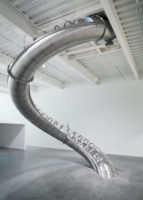| Photo © Kevin Mingora/The Morning Call |
|
The four-story ArtsQuest Center and an adjacent structure housing a television studio face hulking blast furnaces on the former Bethlehem Steel campus. |
Bethlehem Steel’s five blast furnaces, with their 285-foot-tall smokestacks wrapped in tangles of metal pipes, embodied the very idea of industry for generations. Beginning in the late 1850s, the company fabricated structural material for a long list of monumental projects, including the Golden Gate Bridge and the Chrysler Building. But by the time I was growing up near Bethlehem in the 1980s, the furnaces stood as emblems — for eastern Pennsylvanians and, thanks to a Billy Joel song about my native Allentown, for the rest of the country as well — of the economic and cultural fallout from the decline of U.S. manufacturing. In November 1995, Bethlehem Steel shut down the last operations at its sprawling campus along the Lehigh River.
Looming ruins from an industrial antiquity, the furnaces now form a dramatic backdrop for the ArtsQuest Center. The $26.6 million project was designed by local firm Spillman Farmer Architects to house performance spaces for an eclectic program ranging from pop music to comedy, as well as two art house movie theaters. The center opened in early May, with final stages of construction slated for completion this month.
The 65,000-square-foot, new-construction building stands directly across from the furnaces, orienting its performance halls toward the towering stacks, and bringing life back into a section of Bethlehem that was once the city’s economic heart. “We made it very clear that the most important buildings on the site had already been constructed,” says Jeffrey A. Parks, director of ArtsQuest, the nonprofit that operates the center as well as Musikfest, a summer concert series now in its 28th year. “The [performance] spaces had to have great sound, but they also had to have a great view of the furnaces.”
Spillman Farmer designed the center as a simple, four-story box clad in gray precast concrete panels and separated into two conjoined volumes. On the ground floor, a ticketing counter and a pair of 100- and 200-seat movie theaters occupy the south side, while a double-height lobby with concessions and a gift shop looks through the building’s glazed north facade across a public plaza to the foot of the steel stacks.
Steel is everywhere inside the project, from exposed supports to finishes, all painted a bright international orange — the color of the Golden Gate Bridge. Ironically, the material was fabricated in Erie, on the other side of Pennsylvania. Occupying half of the top two floors, the main performance venue accommodates 450 at cabaret-style tables, or 900 standing. Backed up against the glazed facade, the stage hovers in front of the steel stacks.
A rough but elegant version of a theater’s grand stair, a 40-foot-high steel spiral with concrete treads, provides circulation from the performance space down to a mezzanine and an exterior balcony.
In 2007, the Las Vegas Sands Corporation acquired 126 acres of Bethlehem Steel property, and when a garish casino and a bland hotel tower went up on the east side of the site, some locals worried that a place that seemed inseparable from the city it forged was becoming utterly detached from its context and history. But the new ArtsQuest building is only the first of several projects, including a public television studio adjacent to the center, planned for 10 acres on the western side of the site, which the owners have donated as a cultural campus. With nightly performances, as well as a weekly farmers’ market and other community programming, it already draws residents (in addition to bussed-in gamblers) to the industrial hub where many of their parents and grandparents once worked.
The planners have also left the entire site very raw. The honesty of the treatment gives a sense of history to the environment. Buildings from various eras of the site’s manufacturing past — some intact, some skeletal — ring the project. “This is the Rust Belt. Let’s celebrate that,” says Parks. “Let’s have some fun with it.”
















Post a comment to this article
Report Abusive Comment